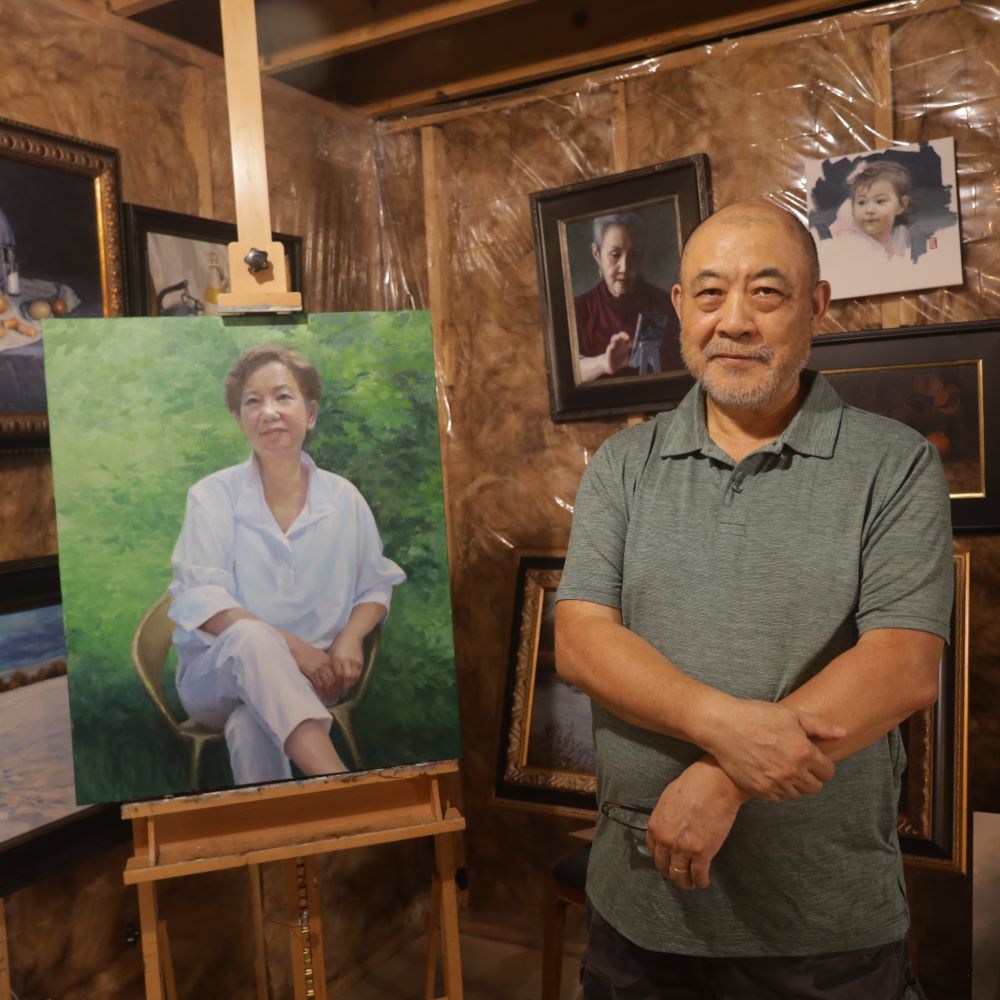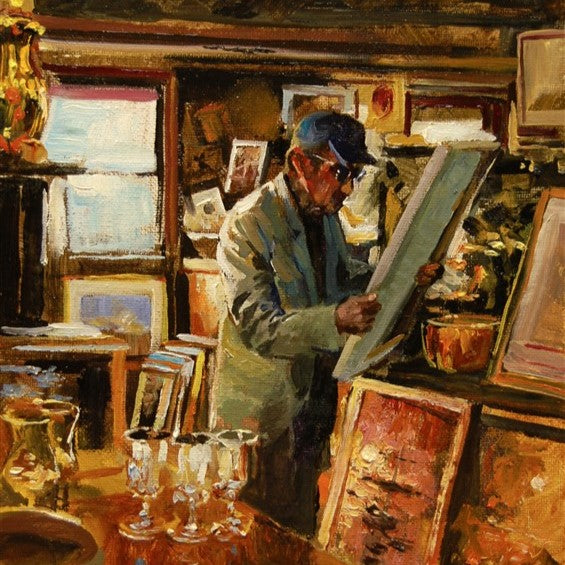A Creative Interview With Artist Shuxing Fan



"When I paint on a canvas in my studio, I think of it as a stage. Every element in the composition becomes a character, each with a role to play."
Artist Shuxing Fan paints classical scenes that reflect his lifelong passion for visual storytelling. His artistic journey began at the age of five, when he transformed his family's living room floor into a giant chalkboard to draw pictures for his playmates. Trained in Scene Design at the Central Academy of Drama in Beijing and Boston University, he has built a career spanning over three decades, designing sets for Broadway shows, national television, and international corporate events. People saw his works on stages and screens, but never in a gallery. Upon his retirement, Shuxing returned to painting to fulfill his childhood dream. Today, he works from his basement studio in Madison, Wisconsin.
Can you tell us about your background in art?
I was born in China and moved to the United States in the mid-1980s to pursue my MFA in theatrical set design. Although studio art did not become my full-time focus until my retirement three years ago, painting, drawing, and sculpting have always been foundational elements of my set design practice. My cultural heritage and professional background give me a unique perspective in the creative process, directly shaping the decisions I make and the outcomes of my work.
Tell us about your evolution as an artist.
I began drawing at the age of four, sketching scenes from trips to the market with my grandmother to share with my childhood friends. Those early doodles were not about creating art in the traditional sense—they were a natural extension of how I communicated and made sense of the world. From the very beginning, storytelling has been at the heart of my artistic journey.
While I have been an artist for much of my life, my focused exploration of oil painting began more recently. As a serious artist, I strive to present the world through my own lens, rooted in personal observation and lived experience. I believe that my work resonates most deeply with those who share similar aesthetics, values, and philosophical outlooks, creating a meaningful connection between the viewer and the art.
How did you develop your skills as an artist?
In my twenties, I studied privately under several of China’s nationally renowned artists before formally enrolling in the set design program at the Central Academy of Drama—the most prestigious theater arts institution in China. The training was rigorous, requiring a minimum of 24 hours of studio art courses each week, excluding homework and the month-long landscape painting trips at the end of each semester, which spanned the entire four-year curriculum. Supporting courses such as art history, aesthetics, and philosophy were structured with a dual focus on both Chinese and Western traditions. This immersive and demanding environment not only built my technical foundation but also fostered a deep and lasting commitment to art. Over time, my ability to evaluate creative approaches across both Eastern and Western perspectives became a defining strength—one that has supported and enriched my entire professional career.
What are you most proud of?
Beyond my extensive artistic experience, teaching is the achievement I am most proud of. “Shuxing is a born teacher”—this was how my professors described me, both in my undergraduate program in China and later in graduate school in the United States. Teaching has been a central and deeply fulfilling part of my career. It has allowed me not only to guide students toward reaching their full potential but also to continuously learn and grow alongside them.
Can you share one of your most rewarding experiences as a teacher?
One of my most recent and rewarding teaching experiences took place after my retirement, when I mentored a high school student preparing for college-level art studies. Over the course of a year and a half, she made remarkable progress in drawing and oil painting under my detailed instruction. Her efforts were recognized with acceptances to several prestigious national art programs, including the School of the Art Institute of Chicago, Columbia University, and the Rhode Island School of Design. Ultimately, she chose to attend Princeton University. Her success stands as a meaningful reflection of the impact teaching continues to have on my life and legacy.
Do you have any studio rituals that help you get into a creative flow?
Upon my retirement from teaching set design at the University of Wisconsin - Madison, I felt I could finally have time to return my focus on studio art to continue my childhood dream. I set up my studio in my basement, which provides a spacious and quiet environment for focused work. I also maintain a computer room equipped with a high-performance workstation, allowing me to explore digital creativity through 3D and video game design applications, since the digital tools have been the standard in my design practice.

Is there an artwork from another artist that has had a significant impact on you?
When it comes to my artistic interests, I find the greatest inspiration in the works of Rembrandt, Courbet, Millet, and several 19th-century Russian painters such as Repin, Surikov, and Levitan—artists whose influence I undoubtedly inherited from my mentors.

What’s your favorite museum?
Having lived in Boston while pursuing my MFA at Boston University, and later in Fairfax, Virginia, during my time at the National Scenery Studio and George Washington University, I developed a deep appreciation for the Boston Museum of Fine Arts and the Smithsonian National Gallery. I often find myself sitting quietly in front of a Rembrandt painting, imagining the moment he created it—the atmosphere in his studio, the light, the solitude, and the emotion behind every brushstroke.

What do you hope collectors see in your art?
I maintain an art store website and an Instagram account to connect with my audience and collectors who share my artistic vision, style, and techniques. I believe that those who collect my work—including commissioned pieces—do so for more than just decorative purposes. They see something deeper and more personal in the art. As one collector remarked about a portrait I painted of her granddaughter: “The portrait captures the innocent yet mischievous expression of the little girl and conveys a spiritual message. We will pass this work down from generation to generation because it preserves a moment that will remain unforgettable for our entire family.” Such responses affirm the emotional resonance I strive to achieve in every piece I create.
Is there anything else you’d like to share to help viewers better understand your work?
My painting—or more broadly, my creative process—often begins with a visual trigger: a scene, an object, a person, or even a pet that holds the potential for storytelling. As a lifelong set designer, I’m accustomed to beginning my work by analyzing a script. With a strong foundation in fine art, I would then approach the stage as my canvas, painting with scenic structures, lighting, and performers as my colors and brushstrokes.
Now, when I paint on a physical canvas in my studio, I continue to think of it as a stage. Every element in the composition becomes a character, each with a role to play. I believe that a successful piece of art should convey a dynamic interplay between leading and supporting elements, revealing their relationships and visual conversations. These interactions should guide the viewer’s eye through a purposeful sequence across the composition. By examining whether these narrative tasks have been fulfilled, I can determine when a work is complete. In this way, I approach set design as a moving painting, and painting as a captured moment of theatrical drama.







